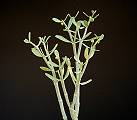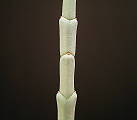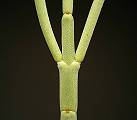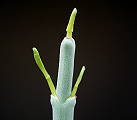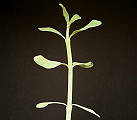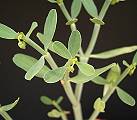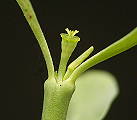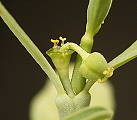|
Euphorbia spec. aff. juttae |
|
|
Fotos |
1 Wuchsform 2
Stamm 3 Verzweigung 4 Junger Trieb 5 Ast mit
Blättern 6 Blätter und Cyathien 7
Cyathium, weibliches Stadium 8 Cyathium, männliches
Stadium, und Frucht |
|
Photos |
1 Growth form
2 Stem 3
Branching 4 Young shoot 5 Branch with
leaves 6 Leaves and cyathia 7
Cyathium, female state 8 Cyathium, male state, and fruit |
|
Heimat |
Australien ? |
|
Habitat |
Australia ? |
|
Wuchsform |
|
|
Growth
form |
|
|
Cyathien |
|
|
Cyathia |
|
|
Kalender |
|
|
Calendar |
|
|
Kultivierung |
|
|
Cultivation |
|
|
Min. Temperatur |
12°C |
|
Min. temperature |
54° F |
|
Schädlinge &
Krankheiten |
(keine beobachtet) |
|
Pests and diseases |
(not any observed) |
|
Ähnliche Arten |
|
|
Similar species |
|
|
Weitere Informationen |
Obwohl diese Art eine
echte Sukkulente ist, weicht ihr Verhalten von dem „normaler“ sukkulenter
Euphorbien ab. Sie ist extrem fruchtbar und auch extrem einfach und schnell
aus Samen zu ziehen. Nur 3 Monate nach der Aussaat habe ich aus den Samen
wieder blühende und Früchte tragende Pflanzen ziehen können. Andererseits
sind die Pflanzen offensichtlich recht kurzlebig. Je älter sie werden, um so
schwieriger wird es, sie am Leben zu erhalten. Diese Pflanzen waren im
Handel (Specks) als E. juttae erhältlich, doch muss es sich um eine völlig
andere Art handeln. Es gehen Überlegungen dahin, dass es sich um ein
australisches „Unkraut“ handeln könnte. Es besteht eine verblüffende
Ähnlichkeit dieser unbekannten Pflanze mit E. tannensis ssp. eremophila (A.
Cunn.) Hassall vom australischen Inland. Siehe Artikel „Euphorbia tannensis
Spreng. in Australia“ von Paul I.
Forster in Euphorbia Journal, Band 8, insbesondere das Foto auf Seite 44.
Viele Populationen von E. tannensis ssp. eremophila sollen sich wie
einjährige Pflanzen verhalten, die nach den für das trockene Australien
typischen irregulären Regenfällen keimen und Samen ansetzen. Was auch zum
Verhalten der unbekannten Art passen würde. |
|
Additional
information |
Though
it's a true succulent its behavour deviates from "usual" succulent
Euphorbias. This species is extreme fertile and also extreme easy and quick
growing from seed to again fertile plants. I have had grown flowering and
seed setting plants from seed only 3 months after sowing. On the other hand
the plants are obviously only short living. The older they are the more
difficult they are to keep alive. Though
these plants were in the trade (Specks) as E. juttae they must be of a
totally different species. There are thoughts that thea could actually be an
Australian “weed”. There is an amazing similarity between this unknown plant
and E. tannensis ssp. eremophila (A. Cunn.) Hassall from the Australian
inland. See the article „Euphorbia tannensis Spreng. in |
Fanden Sie diese Seite ohne einen linken Rahmen, laden Sie bitte www.euphorbia.de
If you found this page without a left frame
please load www.euphorbia.de
